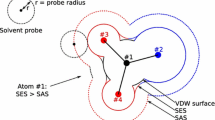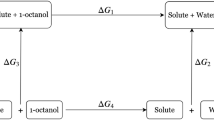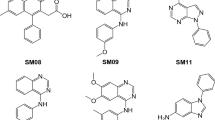Abstract
We present the performance of blind predictions of water—cyclohexane distribution coefficients for 53 drug-like compounds in the SAMPL5 challenge by three methods currently in use within our group. Two of them utilize QMPFF3 and ARROW, polarizable force-fields of varying complexity, and the third uses the General Amber Force-Field (GAFF). The polarizable FF’s are implemented in an in-house MD package, Arbalest. We find that when we had time to parametrize the functional groups with care (batch 0), the polarizable force-fields outperformed the non-polarizable one. Conversely, on the full set of 53 compounds, GAFF performed better than both QMPFF3 and ARROW. We also describe the torsion-restrain method we used to improve sampling of molecular conformational space and thus the overall accuracy of prediction. The SAMPL5 challenge highlighted several drawbacks of our force-fields, such as our significant systematic over-estimation of hydrophobic interactions, specifically for alkanes and aromatic rings.




Similar content being viewed by others
References
Anisimov VM, Lamoureux G, Vorobyov IV, Huang N, Roux B, MacKerell AD (2005) Determination of electrostatic parameters for a polarizable force field based on the classical Drude oscillator. J Chem Theory Comput 1(1):153–168. doi:10.1021/ct049930p
Anisimov VM, Vorobyov IV, Roux B, MacKerell AD Jr (2007) Polarizable empirical force field for the primary and secondary alcohol series based on the classical Drude model. J Chem Theory Comput 3:1927–1946
Applequist J (1977) An atom dipole interaction model for molecular optical properties. Acc Chem Res 10(3):79–85. doi:10.1021/ar50111a002
Applequist J (1993) Atom charge transfer in molecular polarizabilities: application of the Olson–Sundberg model to aliphatic and aromatic hydrocarbons. J Phys Chem 97(22):6016–6023. doi:10.1021/j100124a039
Cisneros GA (2012) Application of Gaussian electrostatic model (GEM) distributed multipoles in the AMOEBA force field. J Chem Theory Comput 8(12):5072–5080. doi:10.1021/ct300630u
Donchev AG, Galkin NG, Illarionov AA, Khoruzhii OV, Olevanov MA, Ozrin VD, Subbotin MV, Tarasov VI (2006) Water properties from first principles: simulations by a general-purpose quantum mechanical polarizable force field. Proc Natl Acad Sci USA 103(23):8613–8617. doi:10.1073/pnas.0602982103
Donchev AG, Galkin NG, Pereyaslavets LB, Tarasov VI (2006) Quantum mechanical polarizable force field (QMPFF3): refinement and validation of the dispersion interaction for aromatic carbon. J Chem Phys 125(24):244107. doi:10.1063/1.2403855
Donchev AG, Galkin NG, Illarionov AA, Khoruzhii OV, Olevanov MA, Ozrin VD, Pereyaslavets LB, Tarasov VI (2008) Assessment of performance of the general purpose polarizable force field QMPFF3 in condensed phase. J Comput Chem 29(8):1242–1249. doi:10.1002/jcc.20884
Patel S, Brooks CL 3rd (2004) CHARMM fluctuating charge force field for proteins: I parameterization and application to bulk organic liquid simulations. J Comput Chem 25(1):1–15. doi:10.1002/jcc.10355
Patel S, Mackerell AD Jr, Brooks CL 3rd (2004) CHARMM fluctuating charge force field for proteins: II protein/solvent properties from molecular dynamics simulations using a nonadditive electrostatic model. J Comput Chem 25(12):1504–1514. doi:10.1002/jcc.20077
Piquemal J-P, Chelli R, Procacci P, Gresh N (2007) Key role of the polarization anisotropy of water in modeling classical polarizable force fields. J Phys Chem A 111(33):8170–8176. doi:10.1021/jp072687g
Piquemal JP, Cisneros GA, Reinhardt P, Gresh N, Darden TA (2006) Towards a force field based on density fitting. J Chem Phys 124(10):104101. doi:10.1063/1.2173256
Piquemal J-P, Gresh N, Giessner-Prettre C (2003) Improved formulas for the calculation of the electrostatic contribution to the intermolecular interaction energy from multipolar expansion of the electronic distribution. J Phys Chem A 107(48):10353–10359. doi:10.1021/jp035748t
Ponder JW, Wu C, Ren P, Pande VS, Chodera JD, Schnieders MJ, Haque I, Mobley DL, Lambrecht DS, DiStasio RA, Head-Gordon M, Clark GNI, Johnson ME, Head-Gordon T (2010) Current status of the AMOEBA polarizable force field. J Phys Chem B 114(8):2549–2564. doi:10.1021/jp910674d
Ren P, Ponder JW (2003) Polarizable atomic multipole water model for molecular mechanics simulation. J Phys Chem B 107(24):5933–5947. doi:10.1021/jp027815+
Rick SW, Stuart SJ, Berne BJ (1994) Dynamical fluctuating charge force fields: application to liquid water. J Chem Phys 101:6141–6156
Shi Y, Xia Z, Zhang J, Best R, Wu C, Ponder JW, Ren P (2013) Polarizable atomic multipole-based AMOEBA force field for proteins. J Chem Theory Comput 9(9):4046–4063. doi:10.1021/ct4003702
Cole DJ, Vilseck JZ, Tirado-Rives J, Payne MC, Jorgensen WL (2016) Biomolecular force field parameterization via atoms-in-molecule electron density partitioning. J Chem Theory Comput 12(5):2312–2323. doi:10.1021/acs.jctc.6b00027
Pereyaslavets LB, Finkelstein AV (2012) Development and testing of PFFSol1.1, a new polarizable atomic force field for calculation of molecular interactions in implicit water environment. J Phys Chem B 116(15):4646–4654. doi:10.1021/jp212474p
Halgren TA, Damm W (2001) Polarizable force fields. Curr Opin Struct Biol 11(2):236–242
Warshel A, Kato M, Pisliakov AV (2007) Polarizable force fields: history, test cases, and prospects. J Chem Theory Comput 3(6):2034–2045. doi:10.1021/ct700127w
Khoruzhii O, Butin O, Illarionov A, Leontyev I, Olevanov M, Ozrin V, Pereyaslavets L, Fain B (2014) Polarizable force fields for proteins. In: Protein modelling. Springer, Berlin, pp 91–134
Hagler AT (2015) Quantum derivative fitting and biomolecular force fields: functional form, coupling terms, charge flux, nonbond anharmonicity, and individual dihedral potentials. J Chem Theory Comput 11(12):5555–5572. doi:10.1021/acs.jctc.5b00666
Mackerell AD, Bashford D, Bellott M, Dunbrack R, Evanseck J, Field M, Fischer S, Gao J, Guo H, Ha S, Joseph-McCarthy D, Kuchnir L, Kuczera K, Lau FTK, Mattos C, Michnick S, Ngo T, Nguyen DT, Prodhom B, Reiher WE III, Roux B, Schlenkrich M, Smith JC, Stote R, Straub J, Watanabe M, Wiorkiewicz-Kuczera J, Yin D, Karplus M (1998) All-atom empirical potential for molecular modeling and dynamics studies of proteins. J Phys Chem B 102:3586–3616
Weiner SJ, Kollman PA, Nguyen DT, Case DA (1986) An all atom force field for simulations of proteins and nucleic acids. J Comput Chem 7(2):230–252. doi:10.1002/jcc.540070216
Cornell W, Cieplak P, Bayly C, Gould I, Merz K, Ferguson D, Spellmeyer D, Fox T, Caldwell J, Kollman P (1995) A second generation force field for the simulation of proteins, nucleic acids, and organic molecules. J Am Chem Soc 117:5179–5197
Jorgensen WL, Tirado-Rives J (1988) The OPLS potential functions for proteins—energy minimizations for crystals of cyclic peptides and crambin. J Am Chem Soc 110:1657–1666
Jorgensen WL, Maxwell DS, Tirado-Rives J (1996) Development and Testing of the OPLS All-Atom Force Field on Conformational Energetics and Properties of Organic Liquids. J Am Chem Soc 118:11225–11236
Levitt M, Lifson S (1969) Refinement of protein conformations using a macromolecular energy minimization procedure. J Mol Biol 46(2):269–279
Allinger NL, Yuh YH, Lii JH (1989) Molecular mechanics. The MM3 force field for hydrocarbons. J Am Chem Soc 111(23):8551–8566. doi:10.1021/ja00205a001
Martin MG, Siepmann JI (1998) Transferable potentials for phase equilibria. 1. United-atom description of n-alkanes. J Phys Chem B 102(14):2569–2577. doi:10.1021/jp972543+
Mobley DL, Wymer KL, Lim NM, Guthrie JP (2014) Blind prediction of solvation free energies from the SAMPL4 challenge. J Comput Aided Mol Des 28(3):135–150. doi:10.1007/s10822-014-9718-2
Nicholls A, Mobley DL, Guthrie JP, Chodera JD, Bayly CI, Cooper MD, Pande VS (2008) Predicting small-molecule solvation free energies: an informal blind test for computational chemistry. J Med Chem 51(4):769–779. doi:10.1021/jm070549+
Geballe MT, Skillman AG, Nicholls A, Guthrie JP, Taylor PJ (2010) The SAMPL2 blind prediction challenge: introduction and overview. J Comput Aided Mol Des 24(4):259–279. doi:10.1007/s10822-010-9350-8
Geballe MT, Guthrie JP (2012) The SAMPL3 blind prediction challenge: transfer energy overview. J Comput Aided Mol Des 26(5):489–496. doi:10.1007/s10822-012-9568-8
Bannan CC, Burley KH, Mobley DL (2016) Blind prediction of cyclohexane–water distribution coefficients from the SAMPL5 challenge
Rustenburg AS, Dancer J, Lin B, Ortwine DF, Mobley DL, Chodera JD (2016) Measuring experimental cyclohexane/water distribution coefficients for the SAMPL5 challenge
Donchev AG, Ozrin VD, Subbotin MV, Tarasov OV, Tarasov VI (2005) A quantum mechanical polarizable force field for biomolecular interactions. Proc Natl Acad Sci USA 102(22):7829–7834. doi:10.1073/pnas.0502962102
Halgren TA (1996) Merck molecular force field. I. Basis, form, scope, parameterization, and performance of MMFF94. J Comput Chem 17(5–6):490–519. doi:10.1002/(sici)1096-987x(199604)17:5/6<490:aid-jcc1>3.0.co;2-p
Misquitta AJ (2013) Charge transfer from regularized symmetry-adapted perturbation theory. J Chem Theory Comput 9(12):5313–5326
Williams HL, Chabalowski CF (2001) Using Kohn − Sham orbitals in symmetry-adapted perturbation theory to investigate intermolecular interactions. J Phys Chem A 105(3):646–659. doi:10.1021/jp003883p
Misquitta AJ, Szalewicz K (2002) Intermolecular forces from asymptotically corrected density functional description of monomers. Chem Phys Lett 357(3–4):301–306. doi:10.1016/S0009-2614(02)00533-X
Misquitta AJ, Jeziorski B, Szalewicz K (2003) Dispersion energy from density-functional theory description of monomers. Phys Rev Lett 91(3):033201
Werner HJ, Knowles PJ, Knizia G, Manby FR, Schütz M (2012) Molpro: a general-purpose quantum chemistry program package. Wiley Interdisciplinary Reviews: Computational Molecular Science 2(2):242–253
Řezáč J, Hobza P (2011) Extrapolation and scaling of the DFT-SAPT interaction energies toward the basis set limit. J Chem Theory Comput 7(3):685–689. doi:10.1021/ct200005p
Nosé S (1984) A unified formulation of the constant temperature molecular dynamics methods. J Chem Phys 81(1):511–519. doi:10.1063/1.447334
Hoover WG (1985) Canonical dynamics: equilibrium phase-space distributions. Phys Rev A 31(3):1695–1697
Berendsen HJC, Postma JPM, van Gunsteren WF, DiNola A, Haak JR (1984) Molecular dynamics with coupling to an external bath. J Chem Phys 81(8):3684–3690. doi:10.1063/1.448118
Khoruzhii O, Donchev AG, Galkin N, Illarionov A, Olevanov M, Ozrin V, Queen C, Tarasov V (2008) Application of a polarizable force field to calculations of relative protein-ligand binding affinities. Proc Natl Acad Sci USA 105(30):10378–10383. doi:10.1073/pnas.0803847105
Van Der Spoel D, Lindahl E, Hess B, Groenhof G, Mark AE, Berendsen HJC (2005) GROMACS: fast, flexible, and free. J Comput Chem 26(16):1701–1718. doi:10.1002/jcc.20291
Kumar S, Rosenberg JM, Bouzida D, Swendsen RH, Kollman PA (1992) THE weighted histogram analysis method for free-energy calculations on biomolecules. I. The method. J Comput Chem 13(8):1011–1021. doi:10.1002/jcc.540130812
Kästner J (2011) Umbrella sampling. Wiley Interdis Rev Comput Mol Sci 1(6):932–942. doi:10.1002/wcms.66
Villa A, Mark AE (2002) Calculation of the free energy of solvation for neutral analogs of amino acid side chains. J Comput Chem 23(5):548–553. doi:10.1002/jcc.10052
MacCallum JL, Tieleman DP (2003) Calculation of the water–cyclohexane transfer free energies of neutral amino acid side-chain analogs using the OPLS all-atom force field. J Comput Chem 24(15):1930–1935. doi:10.1002/jcc.10328
Radzicka A, Wolfenden R (1988) Comparing the polarities of the amino acids: side-chain distribution coefficients between the vapor phase, cyclohexane, 1-octanol, and neutral aqueous solution. Biochemistry 27(5):1664–1670. doi:10.1021/bi00405a042
Klamt A, Eckert F (2000) COSMO-RS: a novel and efficient method for the a priori prediction of thermophysical data of liquids. Fluid Phase Equilib 172(1):43–72. doi:10.1016/S0378-3812(00)00357-5
Misquitta A, Stone A (2007) CamCASP: a program for studying intermolecular interactions and for the calculation of molecular properties in distributed form. University of Cambridge, Cambridge
Acknowledgments
The authors are grateful to the organizers and participants of SAMPL5 for arranging this competition on distribution coefficients, which enabled us to test our in-house software and assess our force-fields. We also would like to thank Anthony Stone for a beautiful and succinct way of visualizing potential maps [57] that inspired us to do the same. We are also thankful to everyone else in our company (in particular Meredith Robert) for supporting our participation.
Author information
Authors and Affiliations
Corresponding author
Additional information
Ganesh Kamath, Igor Kurnikov, Boris Fain and Leonid Pereyaslavets have contributed equally to this work.
Electronic supplementary material
Below is the link to the electronic supplementary material.
Rights and permissions
About this article
Cite this article
Kamath, G., Kurnikov, I., Fain, B. et al. Prediction of cyclohexane-water distribution coefficient for SAMPL5 drug-like compounds with the QMPFF3 and ARROW polarizable force fields. J Comput Aided Mol Des 30, 977–988 (2016). https://doi.org/10.1007/s10822-016-9958-4
Received:
Accepted:
Published:
Issue Date:
DOI: https://doi.org/10.1007/s10822-016-9958-4




